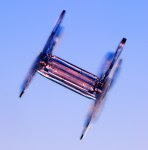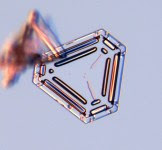Snow is a beautiful site to see. When you see white, frozen liquid falling from the sky covering everything you just can't help to get a smile on your face unless you get a lot of this and you are tired of it. The South just had good snow event where some locations, like Starkville, MS, measured up to 6" of snow!! This is amazing for The South, but have you wondered what it looks like? Looking at a leaf, park bench, car, or anything else and see a bunch of snow and its unique shapes. There are a lot of different classifying charts of the different types of snowflakes. In general, there are about 16 different types of snowflakes. Here is a table to show the various types of shapes of snowflakes.

Now to break down this table into categories and images. The first category that will be mentioned is just simple prisms. These are hexagonal prisms that are the most basic of all of the snowflake types and are some of the smallest. They can be so small that they cannot be seen with the naked eye. Here are some images to give you an idea of what they look like.



Now the next type of snowflakes are the stellar plates. These are very common to see, but are very unique because they have an elaborate and decorative markings on the face of them that makes them look different from all others and from each other. Like other plate-like snowflakes, these typically develop when temperatures are around 28
°F and/or 5
°F. Here are some images of stellar plates.



The other type of plate-like snowflakes are sectored plates. These are similar to the previous plate-like snowflakes, but have more distinguishable edges to them that are more prominent than the others. Here are some pictures of them.



Another type of these kind of snowflakes are double plates. These are very unique snowflake because they are like two plate-like snowflakes connected together. They are very common as well and can be mistaken as the other plate-like snowflakes. Here is what double plates look like.



The last image is what one looks like on its side.
The last of the plate-like snowflakes I will mention is a combination of plates and stars called split plates and stars. These are a type of double plate snowflakes, but differe because one of the plates grows bigger than the other. Just to give you an idea, here is what the look like.



Now I will tell you about a new category called dendrites. The first of this category to mention are stellar dendrites. These snowflakes have branches on them like a tree and are large enough to be seen with the naked eye. Out of all snowflakes these are the most popular to see during the winter holidays. Some examples of stellar dendrites.



The next one is similar to the stellare dendrites but with a fern-like pattern called fernlike stellar dendrites. Their branches look like ferns and are the largest of all the snowflakes. Have a look.


The last dendrite snowflake I will mention is similar to the fernlike stellar dendrite called radiating dendrites, also known as spatial dendrites. What's unique about this type of dendrite is that it is truly 3-D with branches coming out from the center on the sides and the top and back. Two images to give you an idea of what it looks like.


The first one doesn't look different from the stellar dendrite, but if you look at the blurred spot that is branches that are being looked down from a microscope.
Now I will mention another category called columns which are a very unique snowflake because they dont have branches most others do. The first of the columns are called hollow columns. These are small columns of snowflakes that are formed from hexagonal columns that form a hollow region on both ends. Here are a few neat images.



Another type of columns are called capped columns. These are snowflakes that start out as a column, but blow up at then ends as plate-like crystals.




The next category is very common to see and unique because it is one of the slenderest snowflakes out there. They are called needles. Typically are grown around 23
°F and look like stubbles of white hair. See for yourself.



One of the most unique snowflakes is the 12-sided snowflake. These are basically two 6-sided snowflakes that grow together with one turned 30
°. Here are a few pictures of these rare snowflakes.



Another individual snowflake that has its own category is called bullet rosettes. These are snowflakes that are formed from a particluar nucleus ice grain that produces column-like crystals at various orientations. Some of these column-like crystals can be capped with a plate-like ice crystal. To give you a better idea of what they look like I will show you a few images.



The last category I will mention about are called crystals. Of these crystals, I will start off talking about triangular crystals. These are, conveniently, triangular snowflakes that form around 28
°F. They are as unique as they are rare and can sometimes be seen as an odd version of a stellar plate. Check out these triangular figures.



Following up are rimed crystals. These types of snowflakes can come in different shapes such as plates or dendrites. What makes them unique is that they have frozen water droplets on them which is where they get the name rimed crystals. Have a look at these very common types of snowflakes.



Finally, I will mention the most common and most unorganized snowflake out of all of the snowflakes and that is irregular crystals. These are small snowflakes that are combined by random ice crystals that attacked to each other which gives it its indefinite shape. Let's look at these oddballs.


This concludes the different types and shapes of snowflakes. Snow is always fun to look at, but sometimes it is even more fun just to see what kind of snow is falling. Knowing the shapes and types will give you a better idea of how cold it is and what kind of conditions are going on in the air. All images are from "A Guide to Snowflakes" from snowcrystals.com. If you want more, detailed information about snowflakes go visit
http://www.its.caltech.edu/~atomic/snowcrystals/class/class.htm and it will give you a much better idea of all that takes place in making these wonders of nature.